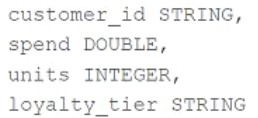Master Databricks-Machine-Learning-Associate Exam with Reliable Practice Questions
A data scientist wants to efficiently tune the hyperparameters of a scikit-learn model in parallel. They elect to use the Hyperopt library to facilitate this process.
Which of the following Hyperopt tools provides the ability to optimize hyperparameters in parallel?
Correct : B
The SparkTrials class in the Hyperopt library allows for parallel hyperparameter optimization on a Spark cluster. This enables efficient tuning of hyperparameters by distributing the optimization process across multiple nodes in a cluster.
from hyperopt import fmin, tpe, hp, SparkTrials search_space = { 'x': hp.uniform('x', 0, 1), 'y': hp.uniform('y', 0, 1) } def objective(params): return params['x'] ** 2 + params['y'] ** 2 spark_trials = SparkTrials(parallelism=4) best = fmin(fn=objective, space=search_space, algo=tpe.suggest, max_evals=100, trials=spark_trials)
Hyperopt Documentation
Start a Discussions
A data scientist uses 3-fold cross-validation and the following hyperparameter grid when optimizing model hyperparameters via grid search for a classification problem:
Hyperparameter 1: [2, 5, 10]
Hyperparameter 2: [50, 100]
Which of the following represents the number of machine learning models that can be trained in parallel during this process?
Correct : D
To determine the number of machine learning models that can be trained in parallel, we need to calculate the total number of combinations of hyperparameters. The given hyperparameter grid includes:
Hyperparameter 1: [2, 5, 10] (3 values)
Hyperparameter 2: [50, 100] (2 values)
The total number of combinations is the product of the number of values for each hyperparameter: 3(valuesofHyperparameter1)2(valuesofHyperparameter2)=63(valuesofHyperparameter1)2(valuesofHyperparameter2)=6
With 3-fold cross-validation, each combination of hyperparameters will be evaluated 3 times. Thus, the total number of models trained will be: 6(combinations)3(folds)=186(combinations)3(folds)=18
However, the number of models that can be trained in parallel is equal to the number of hyperparameter combinations, not the total number of models considering cross-validation. Therefore, 6 models can be trained in parallel.
Databricks documentation on hyperparameter tuning: Hyperparameter Tuning
Start a Discussions
An organization is developing a feature repository and is electing to one-hot encode all categorical feature variables. A data scientist suggests that the categorical feature variables should not be one-hot encoded within the feature repository.
Which of the following explanations justifies this suggestion?
Correct : A
The suggestion not to one-hot encode categorical feature variables within the feature repository is justified because one-hot encoding can be problematic for some machine learning algorithms. Specifically, one-hot encoding increases the dimensionality of the data, which can be computationally expensive and may lead to issues such as multicollinearity and overfitting. Additionally, some algorithms, such as tree-based methods, can handle categorical variables directly without requiring one-hot encoding.
Databricks documentation on feature engineering: Feature Engineering
Start a Discussions
A data scientist has created a linear regression model that uses log(price) as a label variable. Using this model, they have performed inference and the predictions and actual label values are in Spark DataFrame preds_df.
They are using the following code block to evaluate the model:
regression_evaluator.setMetricName("rmse").evaluate(preds_df)
Which of the following changes should the data scientist make to evaluate the RMSE in a way that is comparable with price?
Correct : D
When evaluating the RMSE for a model that predicts log-transformed prices, the predictions need to be transformed back to the original scale to obtain an RMSE that is comparable with the actual price values. This is done by exponentiating the predictions before computing the RMSE. The RMSE should be computed on the same scale as the original data to provide a meaningful measure of error.
Databricks documentation on regression evaluation: Regression Evaluation
Start a Discussions
A data scientist is working with a feature set with the following schema:

The customer_id column is the primary key in the feature set. Each of the columns in the feature set has missing values. They want to replace the missing values by imputing a common value for each feature.
Which of the following lists all of the columns in the feature set that need to be imputed using the most common value of the column?
Correct : B
For the feature set schema provided, the columns that need to be imputed using the most common value (mode) are typically the categorical columns. In this case, loyalty_tier is the only categorical column that should be imputed using the most common value. customer_id is a unique identifier and should not be imputed, while spend and units are numerical columns that should typically be imputed using the mean or median values, not the mode.
Databricks documentation on missing value imputation: Handling Missing Data
If you need any further clarification or additional questions answered, please let me know!
Start a Discussions